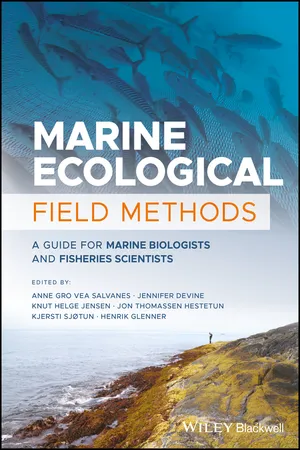
Marine Ecological Field Methods
A Guide for Marine Biologists and Fisheries Scientists
- English
- ePUB (mobile friendly)
- Available on iOS & Android
Marine Ecological Field Methods
A Guide for Marine Biologists and Fisheries Scientists
About this book
A comprehensive, clear, and detailed guide to procedures for conducting marine ecological field studies
Marine Ecological Field Methods is a comprehensive resource that offers the most relevant sampling methodologies for quantitative and qualitative studies of mesopelagic, demersal, littoral, and soft-bottom organisms, as well as relevant physical parameters. The authors describe how various sampling gears work, how to operate them, their limitations, guides on sorting and measuring collected organisms, and how to deal with subsamples of large catches. The text also explains how to use acoustic equipment for monitoring aggregations of organisms, for example fish shoals, as well as the use of sensors for registering environmental variables such as salinity, temperature, oxygen, and light.
The text contains cutting-edge research techniques that are in their final stages of development for use in research surveys. Marine Ecological Field Methods is designed to help with the entire procedure for conducting a field study, including the generation of hypotheses, planning field collection of data, conducting field work, data exploration and statistical analysis with the use of R, and presentation of results in a final report. This essential resource:
- Covers a wide range of techniques and methods for the marine environment
- Includes tried and trusted methodologies and techniques from a team of noted experts in the field
- Contains information on sampling equipment ranging from those that are useful in the littoral zone to shallow nearshore areas, including bottles, secchi discs, and gillnets, and finally large trawls, benthic sleds, ROV and advanced technologies for remote sensing in the open ocean.
- Explores the step-by-step procedures for conducting a field study, from formulating hypotheses to the process of registering and reporting results
Written for students and professionals in the field, this vital resource describes marine ecological sampling equipment, methods and analysis, ranging from physical parameters to fish, microalgae, zooplankton, benthos and macroalgae.
Frequently asked questions
- Essential is ideal for learners and professionals who enjoy exploring a wide range of subjects. Access the Essential Library with 800,000+ trusted titles and best-sellers across business, personal growth, and the humanities. Includes unlimited reading time and Standard Read Aloud voice.
- Complete: Perfect for advanced learners and researchers needing full, unrestricted access. Unlock 1.4M+ books across hundreds of subjects, including academic and specialized titles. The Complete Plan also includes advanced features like Premium Read Aloud and Research Assistant.
Please note we cannot support devices running on iOS 13 and Android 7 or earlier. Learn more about using the app.
Information
1
The Marine Environment

Table of contents
- Cover
- Title Page
- Table of Contents
- List of Contributors
- Foreword
- Acknowledgements
- 1 The Marine Environment
- 2 Planning Marine Field Studies
- 3 Sampling Gears and Equipment
- 4 Sorting Specimens and Preserving Materials
- 5 Data Analysis
- Index
- End User License Agreement